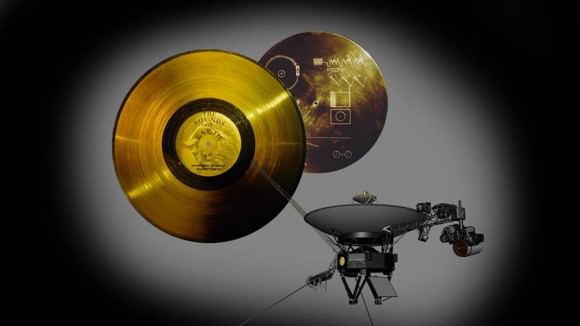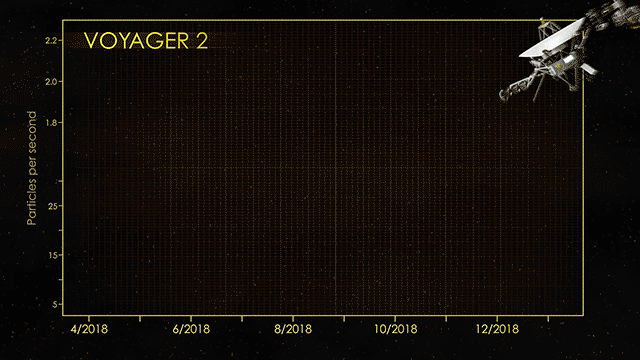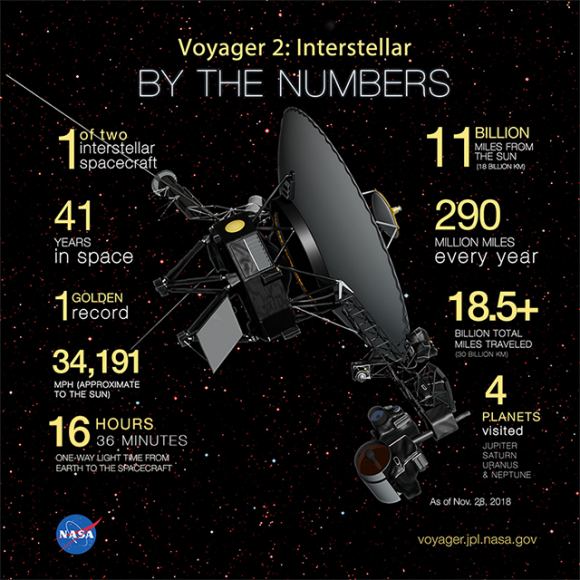On August 25th, 2012, the Voyager 1 spacecraft accomplished something no human-made object ever had before. After exploring the Uranus, Neptune, and the outer reaches of the Solar System, the spacecraft entered interstellar space. In so doing, it effectively became the most distant object from Earth and traveled further than anyone, or anything, in history.
Well, buckle up, because according to NASA mission scientists, the Voyager 2 spacecraft recently crossed the outer edge of the heliopause – the boundary between our Solar System and the interstellar medium – and has joined Voyager 1 in interstellar space. But unlike its sibling, the Voyager 2 spacecraft carries a working instrument that will provide the first-ever observations of the boundary that exists between the Solar System and interstellar space.
To recap, the Voyager 1 and 2 probes departed from Earth in 1977 on a mission that would eventually take them beyond the planets of the outer Solar System and into the space beyond – going where no spacecraft had ever gone before. In addition to revealing things about the gas giants and their systems of moons, the two spacecraft also carried copies of the Golden Record, a phonograph recording that contains sounds and images of Earth.
In this respect, the Voyager missions (like the Pioneer 10 and 11 missions that preceded them) were intended to serve as our robotic ambassadors to the stars. If ever the probes were to reach another star system where an extra-terrestrial intelligence (ETI) existed, these records would communicate the story of our world in a language an alien species could understand.
Initially, the two spacecraft were intended to last for five years and provide close-up studies of Jupiter and Saturn. However, as the mission continued and evolved, the mission control teams planned additional flybys of Uranus and Neptune. This was followed by the Voyager Interstellar Mission (VIM), a mission extension which would allow the spacecrafts to investigate the heliosphere and the interstellar medium.
In the end, the Voyager spacecraft have traveled well beyond their original destinations and remained in operation for 41 years – making them NASA’s longest running missions. As Suzanne Dodd, the Voyager project manager at NASA’s Jet Propulsion Laboratory (JPL), said in a recent NASA press release:
“I think we’re all happy and relieved that the Voyager probes have both operated long enough to make it past this milestone. This is what we’ve all been waiting for. Now we’re looking forward to what we’ll be able to learn from having both probes outside the heliopause.”

At present, the Voyager 2 probe is more than 18 billion km (11 billion mi) distant from Earth, which means that signals sent to and from the spacecraft take about 16.5 hours to reach their destination. That means that the spacecraft is at a distance that is over 120 times that which exists between the Earth and the Sun. The best indication that Voyager 2 had exited from the heliosphere came last week (on Wednesday, Dec. 5th).
It was at this time that its onboard Plasma Science Experiment (PLS) observed a steep decline in the speed of plasma flowing from the Sun (aka. solar wind). This plasma envelopes the Solar System in a protective bubble known as the heliosphere. Prior to Dec. 5th, the space surrounding the Voyager 2 was predominately filled with fast-moving solar wind particles.
Since that time, the plasma instrument has observed no solar wind flowing in the environment around the spacecraft, which led mission scientists to determine with confidence that the probe had left the heliosphere. As John Richardson, the principal investigator for the PLS instrument and a principal research scientist at MIT, expressed:
“Working on Voyager makes me feel like an explorer, because everything we’re seeing is new. Even though Voyager 1 crossed the heliopause in 2012, it did so at a different place and a different time, and without the PLS data. So we’re still seeing things that no one has seen before.”

Other evidence was provided by Voyager 2‘s cosmic ray subsystem, its low energy charged particle instrument and its magnetometer, all of which indicated that the spacecraft had crossed into the interstellar medium. With these instruments now recording an increase in galactic cosmic rays (GCRs), scientists expect to get a clearer picture of the environment Voyager 2 is now traveling through.
In particular, the Voyager spacecraft are showing how our heliosphere interacts with the constant interstellar wind flowing from outside our Solar System. These observations complement data provided by NASA’s Interstellar Boundary Explorer (IBEX), which is remotely sensing that boundary. It will also provide information that the Interstellar Mapping and Acceleration Probe (IMAP) – scheduled to launch in 2024 – will build on.
Nicola Fox, director of the Heliophysics Division at NASA Headquarters, summarized the contributions of the Voyager program thusly:
“Voyager has a very special place for us in our heliophysics fleet. Our studies start at the Sun and extend out to everything the solar wind touches. To have the Voyagers sending back information about the edge of the Sun’s influence gives us an unprecedented glimpse of truly uncharted territory.”
While the probes are technically in interstellar space, it is important to note that they have not left the Solar System just yet. The outermost boundary of our Solar System is considered to be the Oort Cloud, which the Voyager spacecraft will reach in about 300 years. At their current speed, it will be roughly 300,000 years before they pass beyond it.

Unfortunately, the Voyager Interstellar Mission will stop providing scientific data long before then. Both spacecraft are powered by radioisotope thermal generators (RTG), which use the heat caused by the decay of radioactive elements to generate electricity. The power output of the RTGs diminishes by about four watts per year, which means that the spacecrafts’ ability to generate adequate electrical power will come to an end by 2020.
Nevertheless, we can expect some very interesting scientific finds between now and then. The Voyager missions are now in a region of space where no spacecraft has ever ventured, which means every find they make will be the first of its kind. So we should all be ready for some historic firsts before these two probes run out of juice!
The Voyager story has had a major impact that goes well beyond the scientific and astronomical community. These spacecraft and their mission have also had a profound influence on our culture, film, art and music. What’s more, since the spacecraft could be drifting through space for billions of years, the Golden Records may someday be the only traces of human civilization left.
Good luck Voyagers! May your final years of science operations be characterized by invaluable discoveries of what resides between our Solar System and the depths of interstellar space!
Members of NASA’s Voyager team discussed the recent findings at a news conference at the meeting of the American Geophysical Union (AGU) in Washington. The conference took place on Dec. 10th at 11 a.m. EST (8 a.m. PST) and was live-streamed via NASA Live. You can catch the recap below:
Further Reading: NASA


You have a math error here. “At present, the Voyager 2 probe is more than 18 billion km (11 billion mi) distant from Earth, which means that signals sent to and from the spacecraft take about 16.5 hours to reach their destination. That means that the spacecraft is at a distance that is twice that which exists between the Earth and the Sun.”
The last sentence in this paragraph is inaccurate….